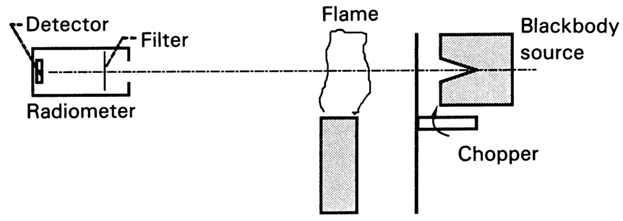|
EXPERIMENTAL EXAMINATION OF SOOT CONCENTRATION
One technique to obtain information on the soot-concentration
quantity Ck2, as in Eq. (D-16) for the visible region, is to
sight through the flame onto a cold black background with a pyrometer and match
the brightness of the pyrometer filament to that of the flame while using a red
filter and then a green filter. With each filter the pyrometer is also sighted
on a blackbody source, and the source temperatures are obtained that produce the
same brightness as when the flame was viewed. As a convenient simplification at
the small λT for red and green wavelengths when considering typical flame
temperatures, the blackbody intensity can be approximated very well by Wien’s
formula, Eq. (1-20). Then, if Tr is the blackbody temperature
producing the same brightness as the flame did when the red filter was used,
this intensity is
where λr = 0.665 μm. This intensity
can also be written as a spectral emittance of the flame times the blackbody
intensity at the flame temperature,
This yields
Similarly, with a green filter (λg =
0.555 μm),
Now, as a simple approximation, using (D-6) for
kλ
in the visible region, (D-2) becomes
where S is the path length sighted through the flame.
Substitute (D-19) into (D-17) and (D-18) to obtain
These two equations are solved for Tf and
Ck2 to yield the needed measure of the soot concentration as
well as the flame temperature.
As an approximation, Ck2 is assumed
independent of wavelength and is used in (D-2), (D-4), and (D-6) to yield, for a
path length S,
These spectral emittances can be used with the definition in
Eq. (D-12) to evaluate the total emittance of the flame as
Another way to measure flame emittance is to use a radiometer
and a blackbody source with a blackened chopper in front of it that periodically
covers and uncovers the blackbody aperture (Fig. D-8). With the flame turned
off, the voltage signal at the detector from the uncovered blackbody is Vb,
and with the blackbody covered by the chopper it is V0.
With the flame turned on these signals become Vb,f and
V0,f. The measurements are made through a filter so
that they are for a small spectral region Δλ centered about λ. The transmittance
of a path through the flame is
FIGURE D-8 Radiometric measurement of
flame emittance.
Scattering of laser light can be used to measure local soot
concentrations, as discussed in Santoro et al. (1983, 1987). Although scattering
by soot is small, it can be accurately detected with sensitive instrumentation.
Mie scattering theory provides the scattering intensity in a given direction as
a function of soot concentration and optical properties. If values are assumed
for the optical properties, the measured scattering intensities can be used to
obtain local soot concentrations. Usually spherical soot particles are assumed,
and the agglomeration of some of the soot is a source of error. Agglomeration
was found in Ku and Shim (1991) to have little effect on the absorption
coefficient, but it did influence scattering. Another difficulty is in selecting
the soot complex refractive index. In Santoro at al. (1983)
|



